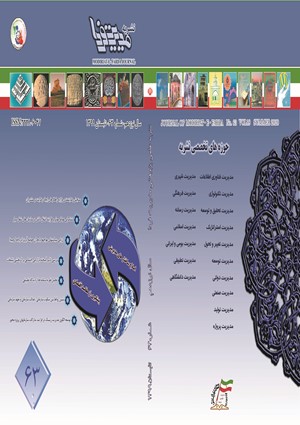Investigating the Relationship between Organizational Performance Evaluation Components (Case Study: Public Sector Purchasing Organization)
Subject Areas :
1 -
2 - عضو هیات علمی
Abstract :
The evaluation of the organizational performance is an important area in management. The significance of the performance evaluation is mainly associated with its necessity for the originations and managers. In other words, if the performance of the organization is not evaluated, its management is hampered. This study aims to examine the relationship between the components of organizational performance evaluation. The research population includes 30 cases chosen from the university lecturers and the elite in the fields of organizational performance evaluation, supply chain, logistics and support. The sample size was determined using the census approach. The research method was descriptive and correlational, and a self-constructed questionnaire—using the Delphi method— was used to collect the data. The validity and reliability of the scale were reported as 0.96 and 0.91, respectively. The obtained data were analyzed using both descriptive and inferential statistics in the form of tables and figures. The data were analyzed by Smart PLS and Structural Equation Modeling. Attempts were made to examine all the factors affecting the logistic organizational performance. Therefore, six main factors and 30 minor factors in the form of 101 items were examined. The results showed that infrastructure and input, growth and learning, results and consequences, stakeholders’ satisfaction, finance and procedures were confirmed as main factors of logistic organizational performance evaluation. The model was also reported powerful according to goodness of fit indices.
• آرمسترانگ, مایکل، (1385). مدیریت عملکرد. تهران: جهاد دانشگاهی دانشکده مدیریت دانشگاه تهران. • بذرافشان میترا. 1394. ارزیابی عملکرد دانشگاه های علوم پزشکی کشور با استفاده از مدل کارت امتیازی متوازن در سال 1392. دانشگاه علوم پزشکی کرمان.
• خلج امه لیلا. 1395. ارزیابی عملکرد استراتژی تولید با استفاده از کارت امتیازی متوزان (از منظر مشتری). ماهنامه پژوهش های مدیریت و حسابداری. شماره 25. ص: 56-75.
• داوری،علی و آرش رضازاده (1392)، مدلسازی معادلات ساختاری با نرم افزار PLS. چاپ اول، انتشارت جهاد دانشگاهی تهران.
• رحمانی, محمد.1384 (Ed.). ارزیابی عملکرد از دیدگاه سیستمی.
• صالحی, مرتضی. (1389). طراحی الگوی ارزیابی عملکرد شعب بانک ها و موسسات مالی و اعتباری (مورد: بانک قوامین) (رساله دکترا). دانشگاه جامع امام حسین, تهران.
• طاهری, شهنام. (1382). بهره وری و تجزیه و تحلیل آن در سازمانها. تهران: هوای تازه.
• نبی زاده کیوی سهیلا. 1391. ارزیابی عملکرد اداره کل اطلاع رسانی کتابخانه ملی جمهوری اسلامی ایران بر اساس مدل کارت امتیازی متوازن. پایان نامه کارشناسی ارشد. دانشگاه علامه طباطبایی.
• نظری احد. سالاریان نیلوفر. 1394. الگوی ارزیابی عملکرد شرکتهای مهندسی مشاور معماری با رویکرد کارت امتیازی متوازن. مهندسی عمران شریف. شماره 2/3. ص: 77-84.
• Estampe, D., Lamouri, S., Paris, J.-L., & Brahim-Djelloul, S. (2013). A framework for analysing supply chain performance evaluation models. International Journal of Production Economics, 142(2), 247–258. Retrieved
• Gallear, D., Ghobadian, A., Li, Y., O’Regan, N., Childerhouse, P., & Naim, M. (2014). An environmental uncertainty-based diagnostic reference tool for evaluating the performance of supply chain value streams. Production Planning & Control, 25(13-14), 1182–1197.
• Lin, L.-C., & Li, T.-S. (2010). An integrated framework for supply chain performance measurement using six-sigma metrics. Software Quality Journal, 18(3), 387–406.
• Manandhar, R., & Tang, J. C. S. (2002). The evaluation of bank branch performance using data envelopment analysis: A framework. The Journal of High Technology Management Research, 13(1), 1–17.
• Marsden, D. (2003). Renegotiating performance: the role of performance pay in renegotiating the effort bargain.


